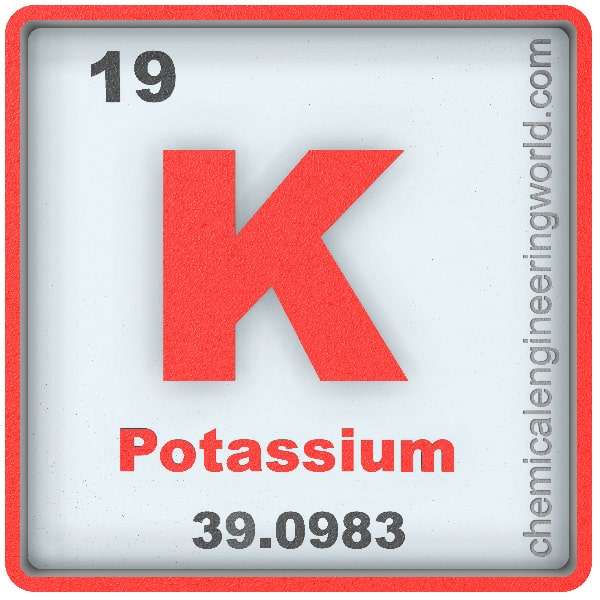Potassium Element Properties and Information

Potassium Element Properties and Information:
Potassium is nineteenth element on the periodic table. Elements are arranged in the periodic table on the basis of the atomic number. Atomic number is the number of protons in the nucleus of the atom. Potassium has an atomic number of 19. It is located in the Group 1 and Period 4 of the periodic table of elements. It is denoted by K. The name is derived from the English word ‘Potash’.
Potassium was not considered an element until Humphry Davy investigated potash in 1807. He exposed moist potash to an electric current which resulted in formation of metallic globules. The metal globules were then analysed to be an entirely new element called potassium.
Potassium is twentieth most abundant element in solar system. Potassium is seventh most abundant metal in teh earth’s crust. The concentration is 2.4% by mass. Most of the potassium is found in igneous rock minerals but it is difficult to obtain potassium from these minerals as the minerals are sparingly soluble. Potassium can be obtained with relative ease from other minerals such as sylvite, sylvinite and carnallite which are found at sites of evaporated seas or lakes. Sea water contains 0.04% potassium by weight.
Physical Properties:
- Potassium is a soft and silvery metal.
- The atomic mass of potassium is 39.098
- The melting point of potassium is 63.2°C
- The boiling point of potassium is 760°C
- The density of potassium is 860 in S.I. units at 0°C
- Potassium is so soft that if can be easily cut with a knife.
- Potassium is second least dense metal after lithium.
- There are 25 known isotopes of potassium among which three isotopes are naturally occurring; potassium-39, potassium-40 and potassium-41. Potassium-39 makes up to about 93.3% of total potassium.
Chemical Properties:
- When potassium is exposed to atmospheric oxygen, it reacts rapidly to form potassium peroxide within seconds of exposure.
- Elemental potassium reacts vigorously with water to form potassium hydroxide; it releases enough heat to burn up hydrogen gas.
- The first ionisation energy of potassium is low due to which it is more likely to acquire a positive charge.
- Potassium-40 is radioactive in nature and decays to form argon.
Methods of Production:
- Electrolysis: This method was developed by Humphry Davy. The potassium metal is produced by electrolysis of its oxide.
- Reaction: The dominant method for commercial production of potassium in 1950s was reaction of sodium with potassium chloride. The sodium replaces potassium in the reversible reaction.
- Griesheimer process: Potassium fluoride is reacted with calcium carbide to produce potassium. The side products obtained are calcium fluoride and carbon.
Relevance in Chemical and Related Industries:
- Fertilizer industries: About 95% of the total commercial potassium produced is used in agricultural fertilizers. Potassium is an essential plant nutrient. The potassium content of most plants ranges from 0.5-2%. About 90% of the potassium supplied to plants as fertilizers is in the form of potassium chloride. The other forms in which the potassium is present in agricultural fertilizer are potassium sulfate and potassium nitrate.
- Chemical industries: Potassium is used for making Potassium compounds which find many uses in Industries and labs. Some of the major potassium compounds are potassium carbonate, potassium hydroxide, potassium chloride, potassium sulfate, potassium nitrate, potassium cyanide, potassium chlorate and potassium bromide.
- Food industries: potassium bromate is used to improve dough strength and rise height. Potassium sodium tartrate is a main constituent in some type of baking soda. Potassium bisulfite is used as food preservatives especially for wines and beers.
Relevance in Other Industries:
- Medicine: When there is low presence of potassium in blood, potassium chloride is administered via slow injections into vein or mouth.
- Laboratories: Alloy of sodium and potassium are used in various labs as heat transfer mediums and desiccants for producing dry and air free solvent.
Health Effects on Exposure:
- Burns: Potassium reacts vigorously with water. It even reacts quite fast with the water vapour present in air. If dust or mists containing potassium is inhaled or gets exposed in eyes it will cause severe burns.
Effects on Surroundings:
- Fire: The potassium reacts so violently with water and releases so much heat that the hydrogen also starts burning. Thus it has potential to cause fire hazard if not handled properly. Many types of fire extinguishers and also water are ineffective in dealing with fire caused due to potassium.
- Low or high levels: Plants required potassium for their growth and development. If the potassium levels are low then it leads to restricted growth, reduced flowering and lower yields. Very high levels of potassium damages the germinating seedlings, inhibits the uptake of other minerals which leads to reduction in the quality of plant or the crop.
References:
































